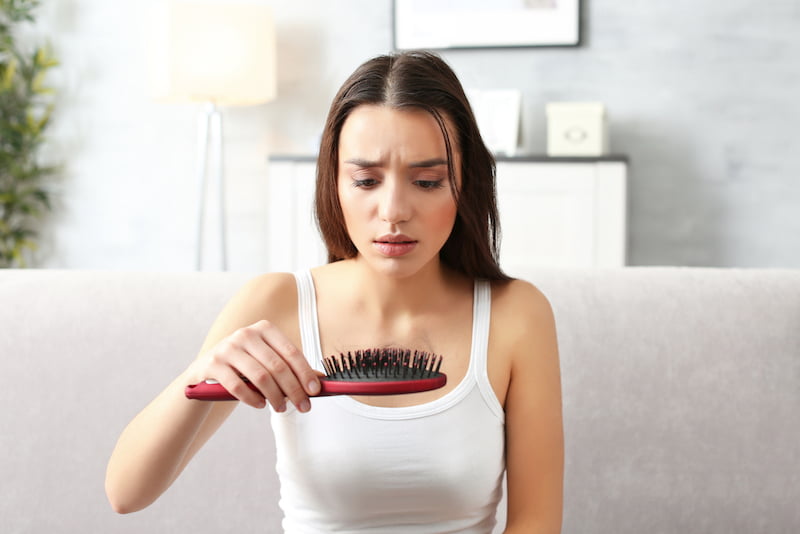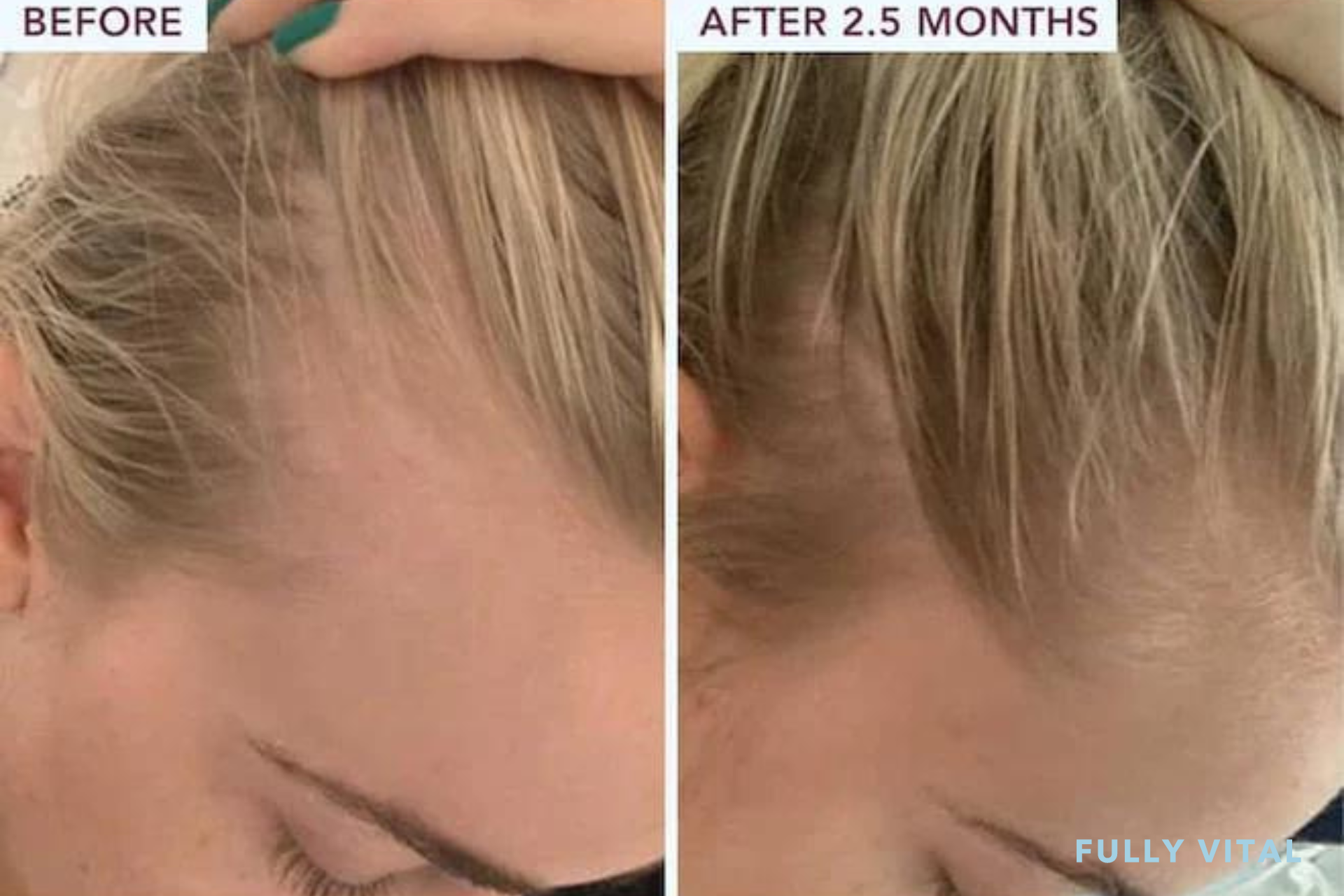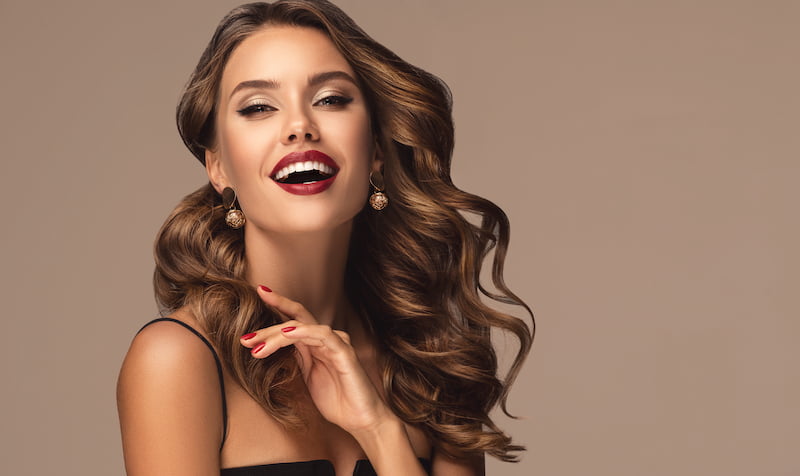
Normal Hair Part vs Thinning: A Complete Guide
Do you have a normal hair part vs thinning hair part?
We get asked this question often, and we want to help you understand this important topic better.
Let's get into hair thinning basics and explore if your part is normal or thinning.

I LOVE MY HAIR NOW
FullyVital hair serum and hair vitamins made tremendous improvements in my hair. I truly love my hair now.
Shop Hair ProductsHow To Know If Your Part Is Thinning
You’re losing more hair than usual
Many women ask, "How can I tell if my hair part is widening?" One of the first signs can be an increase in hair loss.
While it's normal to lose 50 to 100 strands of hair a day (1), if you start noticing a more substantial amount on your hairbrush or shower drain, it might be a signal of hair thinning leading to a wider hair part.
Your part looks wider and you see more of your scalp
Another indicative sign of a widening hair part is visibly more scalp showing.
While observing your hair in the mirror, if you find your usual part appearing wider than it used to, or your scalp seems more exposed, this could suggest hair thinning (2).
Comparing current and past photographs can also provide insight into any changes in your hair part's width over time.
Your ponytail is smaller
A thinner or smaller ponytail is often a subtle indication of hair thinning that women might overlook.
If your once thick and bouncy ponytail now feels noticeably less voluminous or requires more turns of your hair tie, it may suggest your hair part is widening (3).
Your part is forming a Christmas tree pattern
A "Christmas tree pattern" is a term used to describe a specific type of hair loss in women.
This pattern appears when the hair part widens and extends back on the scalp, creating a shape reminiscent of a Christmas tree (4).
If you notice this pattern, it might indicate female pattern hair loss, a common condition affecting many women.
Spotting a widening hair part early can provide you with the advantage of seeking treatment sooner.
Thinning vs. Fine Hair
When delving into "normal hair part vs thinning," it's crucial to distinguish between fine hair and thinning hair.
Fine hair refers to the diameter of individual hair strands - if they're smaller, your hair is 'fine'.
It's important to understand that you have between 80,000 to 150,000 hairs on your head, so having fine hair does not mean that your scalp is showing.
Thinning hair, on the other hand, pertains to the overall density of your hair and the reduction of follicles on your scalp over time (2).
How To Regrow A Thinning Hair Part: Pharmaceutical Treatments
When it comes to combating thinning hair, various pharmaceutical treatments are available.
A. Minoxidil
Minoxidil, popularly known by the brand name Rogaine, is an over-the-counter treatment proven to help slow down hair loss and promote hair regrowth (3).
It's a topical solution applied directly to the scalp, and results can typically be seen after several months of consistent use.
B. Finasteride
Finasteride, a prescription medication, works by blocking the production of a hormone that can cause hair loss (4).
This drug has been found effective for hair regrowth, but it is typically recommended only for men due to potential side effects in women, especially those of childbearing age.
C. Spironolactone
Spironolactone is another medication that some doctors prescribe off-label to women for hair loss.
It works by blocking androgens, hormones that can contribute to hair loss in women (5). Always consult with a healthcare provider before starting any medication.
How To Regrow A Thinning Hair Part: Natural Treatments
Beyond pharmaceuticals, several natural treatments can also contribute to maintaining a healthy hair part and overall hair growth.
A. Hair Growth Vitamins
Certain hair growth vitamins, like biotin, vitamin D, copper and saw palmetto, play a crucial role in hair growth and health (6). These can be consumed through a balanced diet or taken as supplements with the guidance of a healthcare professional.
B. Hair Growth Serums
Topical hair growth serums, often infused with botanicals and essential oils, can nourish and stimulate the scalp, promoting healthy hair growth (7).
C. Derma roller for Hair
Derma rolling, also known as micro-needling, can potentially stimulate hair growth by causing minor skin injuries that trigger the body's healing response, increasing blood flow and nutrient delivery to the scalp (8).
A high quality derma roller for hair can help.
D. Lifestyle and Diet
A balanced diet rich in protein, iron, and various vitamins can support healthy hair. Regular exercise, adequate hydration, and stress management techniques can also play a role in maintaining your hair health (9).
How To Cover Up A Thinning Hair Part
While you're addressing the root causes of your thinning hair, there are ways to manage its appearance.
Hairstyling techniques, like opting for a side part or adding waves or curls, can provide volume and conceal thinning areas.
Hair fibers and tinted dry shampoos can also help camouflage a widening part (10). You could also apply makeup to your scalp to hide the thinning areas.
Normal Hair Part vs Thinning: Final Thoughts
Determining the difference between a "normal hair part vs thinning" can be challenging but understanding the signs and knowing the treatments available is a significant first step.
Whether you choose pharmaceutical treatments, natural alternatives, or a combination of both, remember that patience is essential.
Hair growth takes time, but with persistence, the right treatment, and professional guidance, it's possible to navigate hair thinning successfully.
With a warm approach towards your concerns, we aim to empower you with knowledge to make informed decisions about your hair health.
Remember, you're not alone in this journey, and there's no shame in experiencing hair thinning. It's a common issue faced by many women, and it doesn't define your beauty or worth.
Frequently Asked Questions About Normal Hair Part vs Thinning
Can parting your hair cause thinning?
No, parting your hair does not inherently cause thinning. Changing your part now and then exposes different areas of the scalp which may be already thinning due to other causes.
However, it is good practice to regularly switch up your part to reduce stress on the same set of hair strands.
Finally, changing your part sometimes allows your hair to stand up from the scalp and look more voluminous, which might give the impression of a fuller head of hair.
Is my hair thinning or am I paranoid?
Understanding the difference between normal hair shedding and hair thinning can be a challenge.
While it's normal to lose 50 to 100 strands a day, consistent loss of more than this could suggest hair thinning.
Signs of hair thinning may include a wider hair part, visibly more scalp, or a smaller ponytail. However, stress or paranoia can also cause hair shedding.
If you're unsure, it's best to consult a healthcare provider or a trichologist.
They can provide professional insight into whether your hair is thinning or if your concerns stem from anxiety or misconceptions.
Normal Hair Part Female: What's Normal?
A normal hair part in females can vary based on hair type and personal style.
While there's no one-size-fits-all when it comes to hair parts, many women opt for a middle or side part.
A hair part usually reveals a small section of the scalp, providing a neat division of hair on either side.
However, variations in the width of this part are completely normal and largely depend on hair density, strand thickness, and hair style.
It's important to note that a wider part can sometimes indicate hair thinning, especially if the scalp appears more visible than usual.
But remember, everyone's hair is unique, and what is normal hair part for female in one person may not be the same for another.
Hair Thinning At Part Female: What To Do About It?
Thinning hair at the part in females is a common concern, often linked to conditions like female pattern hair loss.
If your hair part appears wider than usual or if your scalp seems more visible, it could suggest hair thinning.
However, remember, everyone's hair journey is unique.
Other signs of thinning might include a smaller ponytail, more hair shedding, or a "Christmas tree pattern," where the part widens and extends back on the scalp.
Normal hair part vs thinning:
If you are noticing increased hair thinning at part, make sure to see some of the hair loss treatments described above.
References
- American Academy of Dermatology Association. Thinning hair and hair loss: Could it be female pattern hair loss?
- American Academy of Dermatology Association. Is your hair fine, thin, or both?
- U.S. National Library of Medicine. Minoxidil Topical.
- U.S. National Library of Medicine. Finasteride.
- Sinclair R. Female pattern hair loss: a pilot study investigating combination therapy with low-dose oral minoxidil and spironolactone. International Journal of Dermatology.
- Almohanna HM, Ahmed AA, Tsatalis JP, Tosti A. The Role of Vitamins and Minerals in Hair Loss: A Review. Dermatol Ther (Heidelb).
- Garza LA, Liu Y, Yang Z, et al. Prostaglandin D2 inhibits hair growth and is elevated in bald scalp of men with androgenetic alopecia. Sci Transl Med.
- Dhurat R, Sukesh M. Principles and Methods of Preparation of Platelet-Rich Plasma: A Review and Author's Perspective. J Cutan Aesthet Surg.
- Goluch-Koniuszy ZS. Nutrition of women with hair loss problem during the period of menopause. Prz Menopauzalny.
- Bouhanna P, Reygagne P. The effect of hair style on apparent hair density in females with alopecia. J Cosmet Dermatol.
- Batana oil for hair growth








